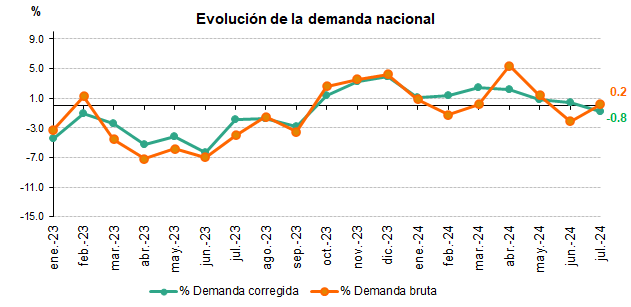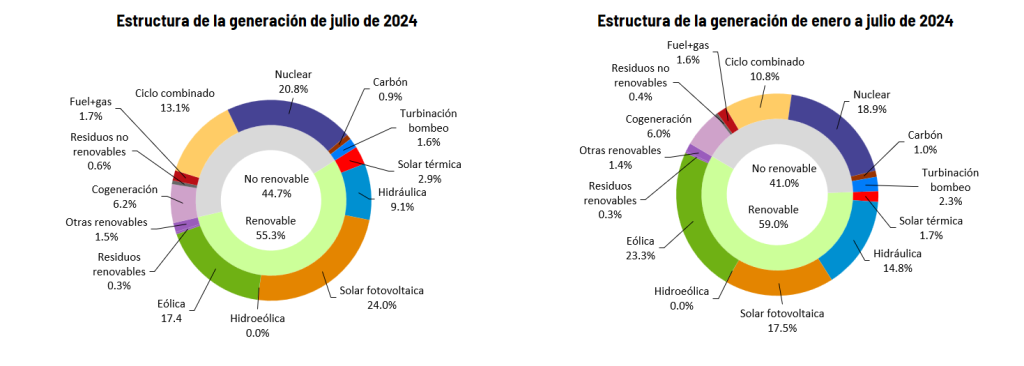The demand for electrical energy in Spain falls by 0.8% in July. For the third consecutive month, solar photovoltaics leads the national generation mix with 24% of the total, the largest share in its history. Monthly production with renewables such as wind power, photovoltaic, hydraulic and solar thermal energy. In our country it meant 55.3% and technologies that do not emit CO2 equivalent reached a share of 77.2%.

National electricity demand experienced a decrease of 0.8% in July compared to the same month of the previous year, once the effects of temperature and work schedule were discounted. In gross terms, a demand of 22,730 GWh is estimated, 0.2% more than that of July 2023.

From January to July 2024, Spain has registered an accumulated demand of 143,572 GWh, 0.6% more than in the same period of 2023. Once the effects of work and temperatures are taken into account, demand grows by 1 % Compared to the same period of the previous year.
This month, renewables generated 13,460 GWh, 23.2% more than in July 2023, and reached a share of the total of 55.3%, this being the third consecutive month in which solar photovoltaics leads the national mix , with 24% of the total. During this month, this technology produced 5,840 GWh, which is 27.7% more than July 2023 and marks a new historical maximum for monthly photovoltaic production.
It should be noted that on July 12, solar photovoltaic broke its daily production record with 211 GWh, which represented a share of 25.1% of the total for that day.
According to the provisional data available today, photovoltaics have been followed by nuclear (20.8%) and wind (17.4%) as technologies with the highest production in July.
With this boost from renewables, 77.2% of the electricity produced in Spain during the month of July 2024 was free of CO2 equivalent emissions.

Peninsular demand falls 0.7%
At the peninsular level and once the effects of work and temperature are taken into account, demand has been 0.7% lower than in July 2023. In gross terms, demand this month has been 21,235 GWh, 0. 4% higher than that of the same month of the previous year.
In the accumulated period from January to July of this year, peninsular demand has been 134,911 GWh, 0.6% higher than that registered in 2023. Once the effects of work and temperatures are taken into account, peninsular demand grows 1% compared to the same period of the previous year.
The total of peninsular renewables generated 57.1% of the total in July, according to the provisional data available today, which shows a production of 13,164 GWh, 24% more than in the same month of the previous year. For their part, emission-free technologies contributed 80.3% of the total.
The peninsular generation structure in July is also led by photovoltaic solar, which has been responsible for 24.9% of the total by producing 5,740 GWh during this month, 27.6% more than in July 2023.
The electrical system in the Balearic Islands and Canary Islands
In the Balearic Islands, electricity demand in July was 5.3% lower than that of the same month in 2023, once the effects of work hours and temperatures are taken into account. Thus, gross demand is estimated at 684,848 MWh, 6.8% less than in July of the previous year. From January to July 2024, the Balearic gross demand is estimated at 3,406,406 MWh, 1.1% less than in the same period of 2023.
In terms of generation, the combined cycle, with 60.7% of the energy produced in the Balearic Islands, was the islands’ first source this month. For its part, renewable energy without CO2 equivalent emissions generated in the Balearic community represented 16.4% of the total. Balearic renewable production grew by 44.5% in July compared to the same month of the previous year.
Furthermore, the underwater link between the Peninsula and Mallorca contributed during this month to covering 30.3% of the Balearic electricity demand, the largest amount of energy recorded to date.
For its part, in the Canary archipelago, the demand for electrical energy increases by 0.6% compared to the same month in 2023, taking into account the effects of work schedules and temperatures. In gross terms, demand was 770,477 MWh, 1% more. In the first seven months of 2024, Canarian demand is estimated at 5,032,216 MWh, 1.9% more than in the same period of 2023.
Regarding electricity generation in the Canary Islands, the combined cycle, with 36.3% of the total, was also the first source in July. Renewables and emission-free technologies reached a share of 28.1% of production, with the wind contribution being 22.5%.


